
WestRock: How XR is Accelerating Manufacturing
- March 15, 2023
Listen and Subscribe on Your Favorite Platform:
Episode Summary
Years ago, a forward-thinking vice president at WestRock said, “we need to look at extended reality technology.” What they didn’t know at the time was that there was a massive global event that would make AR and VR invaluable tools for manufacturers to continue doing business.
COVID-19 accelerated XR – we’ve heard that from companies worldwide – but it pushed forward-thinking manufacturers to innovate with XR even more than they already had planned. Where some manufacturers could no longer do processes physically, WestRock figured out how to do them virtually.
Now, XR is integrating into WestRock warehouses all over the world. In factories, AR tools provide factory workers with guided workflows from remote experts. They now have a library of 360 walkthroughs of facilities for training and new prospects to view. And they provide designers tools for collaborative modeling in AR/VR to produce virtual prototypes and save thousands of dollars on unused physical prototypes.
But it didn’t start there.
How do you show the impact of XR to leadership and veteran employees who are used to more traditional methods? How do you handle the challenges of scale once you see an XR pilot program succeed?
We get into these questions, the story of how WestRock uses XR for business, and more on the podcast.
Key Moments
- Getting started in XR (2:00-3:30)
- How did WestRock first implement XR? (3:35-7:12)
- How is WestRock using AR/VR now? (7:21-9:40)
- Use cases for collaborative modeling (9:42-11:28)
- How do you start an XR pilot program? (11:40-13:15)
- When did XR catch on in the company? (13:15-14:20)
- What challenges did WestRock face scaling XR? (14:30-18:05)
- Preparing XR for scale isn’t just about managing devices (18:05-21:34)
- Will workers and employees actually use XR? (21:35-24:00)
- What makes XR easy to accept for leaders? (24:01-27:45)
- What is your personal “why” for XR? (29:20-32:02)
- What advice do you have for people getting into XR now? (32:04-34:00)

About the Guest
Scott Burkey is a Technology Fellow at WestRock, a global manufacturing and consumer packaging company headquartered in Atlanta, Georgia. He takes a pragmatic approach to implementing new ways of making training more effective and supporting front-line workers. Having worked as a software developer for over 20 years for brands like CNN, TBS/TNT and Coca-Cola, Scott now champions new technologies in the manufacturing industry which he believes will be one of the biggest adopters of augmented and virtual reality.
Prior to WestRock Scott delivered VR products for the National Basketball Association. He serves in an advisory capacity to startups and nonprofits. Scott is a United States Marine Veteran that enjoys running and backpacking with his wife and 4 children in Atlanta, Georgia.
Links and Resources
- Connect with Scott on LinkedIn
- Listen to Scott’s “XR at Work” Podcast
- Connect with Brad on LinkedIn
- Connect with Will on LinkedIn
Learn more about getting started with XR in our ultimate guide to managing VR training for work.
Episode Transcript
Brad Scoggin: Hey there, welcome to “XR Industry Leaders” with ArborXR. My name is Brad Scoggin, and I am the CEO and one of three co-founders of ArborXR. And we’ve had the opportunity of working with thousands of companies since 2016, and we’ve learned a ton about what it takes for XR to be successful in your organization.
Will Stackable: And I’m Will Stackable, co-founder and CMO. This podcast is all about interviewing the leaders who are on the ground making XR happen today. True pioneers in the space from Amazon, Walmart, and UPS to Koch, Pfizer, and beyond to uncover the pitfalls, lessons learned, and secrets that you can use to help grow XR in your organization.
Brad Scoggin: Scott, I was just thinking, I think you’re one of the first, few people in this day and age that I either met or saw in person before over Zoom, but we’re pumped to sit down with you today, and get to know a little bit more about your XR journey.
Scott Burkey: It’s great to be here, even if it is digitally. I’m glad we’re getting a chance to sit down and talk, Brad.
Brad Scoggin: Absolutely. Well, where we always love to start is we wanna hear about your personal journey into XR.
Scott Burkey: Okay, so I’m a web developer by trade. I started off back in the nineties building websites, working on large websites, very large news websites headquartered in Atlanta. And so, I started off as a web developer and building websites, mobile apps, taking live television broadcasts and pushing them to browsers and then to mobile apps, and then to set-top boxes and connected devices like Roku and Amazon Fire and that sort of thing. And so, about six years ago, I got a call into an old employer that was running the MBA’s on digital properties. And they said, “Hey, we wanna take live basketball games, and we wanna push ’em to a new platform. We know you know how to take a live broadcast and push ’em to that content to users. We wanna start pushing to virtual reality headsets.” And I said, “Who the heck wants to sit in a VR headset and watch that live basketball game?” But I was intrigued to find out that somewhere about 40,000 people a night will sit in their living room and watch basketball games in a VR headset.” So I started doing VR about six years ago for the NBA, putting games into headsets. And I really got jazzed about it because, unlike a regular browser or a mobile app, it’s so immersive. And so, I had the opportunity to move from just VR to go into the full spectrum of XR with my day job at WestRock. People say, “What are you doing in XR at WestRock?” And I say, “Everything.” So I got to move from just putting content into virtual reality to now working in AR and VR and 360 and all the above. And so, I’ve found myself now specializing in the extended reality technologies.
Brad Scoggin: Very, very interesting. It seems like a lot of people that we talk to, and even actually our own story with XR, started on the entertainment side a little bit, and we’ve now transitioned into enterprise, which, yeah, it’s just interesting. Maybe now, enterprise I think, is what’s gonna carry XR the next bit of the way, and then it may circle back to the consumer space. But I think another thing our listeners are usually interested in, and of course, us as well, is for WestRock. What’s the process? You got a company like WestRock. They’ve been around for a long time, and what was their process of beginning to take XR seriously? Was that a long process? What’s that been like?
Scott Burkey: Yeah, I mean, so I’ve been here about three and a half years. That’s a great question. We’re an old manufacturing company. You’re exactly right. So we have forestry, paper mills, we turn paper into cardboard, we call it corrugated. We turned paper into cereal boxes and donut boxes and a lot of the stuff you see on grocery store shelves and in fast-food packaging. And we also manufacture machinery and retail displays. So we do a lot of stuff around consumer packaging. And it’s not like the manufacturing industry is super-big on XR, but a very forward-thinking vice president there at WestRock said, “We need to be looking at this. This is where things are going for training for customer engagement. We need to be looking at extended reality technology.” So they reached out to me, and really, when I came to work at WestRock, I mean, I still tell people it’s the coolest job ever, man, because my boss said, that same VP, he said, “Go start knocking on doors, we got 300 factories. Go meet some people, learn the business, take some devices out, start seeing if you can get any kind of awareness and any traction.” And so, I started off just kind of learning about manufacturing. I never worked in manufacturing before and learning about our business and what we produce and what our factories look like, and our mills, and then making some friends and putting some devices in factories. And then COVID hit, and I no longer had to knock on doors anymore. The calls were coming in like crazy. And so, we went real quick during COVID from, “Hey, anybody wanna try this cool VR headset thing I got? It’s the future” We went from that to, travel bans. We can’t get vendors into our factories, we can’t get auditors in from different government regulations. There’s a lot of different things that were stopped. And so, being able to virtually engage with our factories that were in bubbles, that became the deal, right? And I got real popular real quick and I started working from really long days and nights, and it went from me with my little VR headsets and grew to six of us on the team in about a year. So we didn’t have to really, I mean, COVID’s a terrible thing, I mean, absolutely. but it’s been a very good thing for the propulsion of XR and manufacturing because where we were seen before as maybe kind of the quirky, goofy folks in IT that had the weird devices, that everyone’s kind of leery of to all of a sudden it’s like, “We need your help now, we’re trying to keep factories running.” And it’s like, right on, let’s do it.
Will Stackable: So interesting. We’ve heard that many times and from a nice-to-have to a must-have. Can you talk a little bit about how is WestRock actually using AR, VR? I know you all are even using 360 video. Can you give us a little bit of a lay of the land of how you’re using these immersive technologies?
Scott Burkey: Sure, so I categorize it like this, Will. We kind of have four capabilities. Number 1 is we do what we call factory AR, which is remote expert and guided workflows on the heads and in the hands of factory workers. So HoloLens, tablets, Realwear, keeping machines running through Remote Expert and guided workflows. So that’s number 1. Number 2 is we have a pretty large library of 360 walkthroughs of our facilities that we started taking, 360 cameras, and started shooting our factories with 360 panos. And then it started turning to what if we just do 360? And we started doing some hovers for some content for training inside of those 360 experiences. Not just walkthroughs, but training and quizzes and that kind of stuff. So 360’s really grown as well. Still in the factory, but it’s not quite AR, it’s that 360. So that factory AR 360’s blown up for us. It’s become huge. We also do some virtual reality training and collaboration, been very limited coming out of the pandemic where we’re looking to do more, but it had to kind of take a backseat a little bit to maybe AR solutions in our factories. That’s the third thing we do. And a big thing that we do as well, Will, is we do a lot of taking 3D models of our products, consumer packaging, machinery, retail displays and putting them into AR and VR for design collaboration, design iterations with our customers. And so, that’s been huge. We’ve got, we’re probably at about 60 designers right now that can take traditional designs and put ’em into AR and VR for design iterations with our customers. And I think we’re gonna do probably 25 more in Q1 of the next year. So we’re doing a kind of a whole lot of different things.
Will Stackable: I wanna, I’ve got a question that I wanna circle back. With the collaborative modeling that’s a significant program. What’s the biggest benefit you’re seeing? Is it speeding up the process? Is it just less errors and better, higher fidelity for the customer? Where do you see the biggest benefit?
Scott Burkey: Well, it’s tough to just say one, but I’m gonna give you two. Second biggest benefit is that it positioned just very well with some of our…Our buyers are starting to get younger and younger. Our buyers with some cosmetic brands, ’cause remember we do a lot of packaging for cosmetics, make up that sort of thing. A lot of these buyers, they don’t wanna buy from a 100-year-old company that comes out with a three-ring binder portfolio. They wanna interact with a vendor like us in digital means. So that’s been a nice benefit. But really, the number 1 benefit for us is that we’ve been able to cut down the number of physical prototypes we manufacture in design. So you think about that donut case at a convenience store that you open, take your donuts out, take a bite of, put it in the bag, go up and pay. So we make a lot, thousands of those glass, metal, and wood displays. And so, if we can take one physical display design iteration out of the equation, we just saved ourselves a lot. I mean, sometimes 10, 15, $20,000 in a physical prototype and shipping of that to our customer’s facility. And so, that pays for just the removal of one physical prototype, for a customer pays for the whole program there. Man, it’s been very, very helpful.
Will Stackable: I wanna rewind to something you said earlier. So the VP comes to you, and he says, “Scott, go wild, visit some factories, see if this technology makes sense.” So you’ve got the green light, but you don’t, like you said, there’s a lot of momentum in it with a 100-year-old company, of doing things a certain way. So how do you, Scott, go about starting a pilot program, and what were some of the challenges you faced early on with getting buy-in or even figuring out what to do with these immersive technologies?
Scott Burkey: Yeah, so I started off specifically just doing Remote Expert. Let me show you FaceTime on a tablet with annotations, or let me show you FaceTime video conferencing on a head-mounted device, a headset display that someone on the other end can draw on your field of view. So let’s just take really in XR it’s like the simplest thing to do. Remote Expert is very valuable. People go, “Oh,”-
Will Stackable: Blows people’s minds.
Scott Burkey: This is cool, but it’s like, “Eh, it’s really like the easiest thing to do.” So I just started taking Remote Expert and going and put it in place because it brings value, it’s easy, it can be done on a handheld, it doesn’t have to be done on a head-mounted device. And it got me in conversations, building rapport with people, learning the business, finding what Wi-Fi connectivity in our factories is really like, and you can guess what that’s really like in the middle of a factory in rural Oklahoma. Wi-Fi connectivity is not real good, but it got me identifying gaps and issues, and opportunities, and it got me into some relationships and having some good conversations. So that’s the first thing that I did and it really just kinda laid that groundwork for me to build on. And I’m glad I did it that way. Believe me, it was an accident if it was done wisely. It was purely an accident on my part, but it worked out well.
Will Stackable: So, was there a point when you felt like it had kind of caught on organizationally that there was energy and excitement across the board?
Scott Burkey: The first thing that comes to mind is, well, COVID. It certainly caught on then, but I wouldn’t even say, Will, like the real test, has been since travel bans have been lifted in the last year because it’s still got that momentum. People are interested in it because they see the value, not just because they can’t get OEM providers into the factory. That’s when it’s kind of hit that it’s caught on, that this is gonna go somewhere or it’s here to stay is because when we didn’t have to use it, the factories still wanna use it. And so then, just really in the last year, I’ve been like, yeah, this is it, man. It’s not going anywhere because we can have people into our factories, they’re not in a bubble anymore, but no, people are seeing the value, and they realize that it brings a lot of value to the business, yeah.
Brad Scoggin: A couple of follow-ups there. I have like a two-part that that’s related. Where would you say, and like you said, COVID’s so painful, but for a lot of industries, it’s been helpful to accelerate things in a big way. In WestRock’s journey to scale, let’s just use scale as kind of this mythical whatever scale is for WestRock. Where is WestRock at in that journey? At time, are you 50% of the way there and then the follow on is, what challenges are you facing today even with this momentum, even with the COVID kind of accelerant? What challenges are you facing to get to scale?
Scott Burkey: That’s a great question. I talk a lot about this, Brad, because scale is where I think a lot of companies like us are at. When I talk to buddies of mine, guys that y’all know, guys who have my job in other large manufacturing companies, we’re all kind of, over the last year, we’re in the same place, we’re all like, “Okay, well crap, that’s working.” We’re in 10 factories, 20 factories, but we’ve got 300, What you did to get you to 10 factories is not gonna work. That spreadsheet isn’t gonna be the right mechanism for device tracking when you go to 300. Device management from memory or from a spreadsheet or a legal pad, it works for 10 plants, it doesn’t work for 300. So we are really starting to come to a point to where we’re taking and revising our processes and our tools. Certainly, platforms like ArborXR are great for taking successful pilots and turning them into solid, scalable growth processes. And so, that’s right, where we’re at is how do we now turn around and grow because pouring more bodies into doing the same manual processes is not gonna get us where we need to go. So we’re looking at things differently. We’re refortifying our tools, getting better platforms, refining our processes. And I think probably to your question, one of the biggest obstacles we face is as we start to expand. I just got back from England and the Netherlands, working with some XR champions there because our growth strategy is to train others, many XR, many Burkeys, many little groups of XR fanatics in the Far East in South America in Europe. And I just got back from Europe. And the big issues that we’re facing, one of the big issues we’re facing is when you get into some of these other markets, there are restrictions around device purchasing or there are restrictions around content, there’s GDPR. They got a lot of languages in Europe. We got one language in the United States. Well, we got different dialects. We got southern and northern, and California dialects. But over there, I mean, we’ve got people working in factories that work right next to each other, and they don’t speak the same language. And so, the very issue around scale for us is going to be how do we start to deliver things in multicultural, multiethnic kind of environments where everything’s not like Atlanta, Georgia, when you’re in Poland or Eastern Europe or South America. And so, that’s gonna be an issue for us. And so, multi-language capabilities and that sort of thing are gonna be an issue for us, Brad.
Brad Scoggin: Yeah, that’s very interesting. One thing that’s been super encouraging to us as we’ve done several of these interviews now is it really does feel like most companies are maybe in a similar situation that you’ve gotten to the point where we say, “Okay, this works, this is great. Okay, now how do we scale it?” Which I think should be encouraging for all of us. I think it should also be encouraging that a lot of the companies, like you said, your counterparts at other similar companies, these are old-school classic companies that are adopting this new kind of sexy technology. And so, I think that to me, that’s a really positive thing. When we think about scale and the challenges of scale, obviously, with what we do, we do think a lot about the technology side, the platform side of things. But you bring up an interesting point, which is the people side. So maybe talk a little bit about that, just even, I mean, language is one thing, but as you’re trying to get adoption of this across 300 factories in x number of countries, what’s the people side of that look like?
Scott Burkey: The people side. I always thought that the technology was gonna be tough, and I’m pretty good with people. People side was gonna be a little easier. But in true Scott Burkey fashion, it’s always the opposite of what I think walking in. The technology’s really not that tough. The toughest thing for me really has been the people side. And I say that because we have a large population, percentage of our population in our factories that are from my generation, Gen X and older. They’re baby boomers, they’re Gen X, they’re people that are in their fifties and sixties, and we have a fair amount of resistance to taking all this knowledge that they have over years and years. And from their perception is we’re putting it into a leisure device, an entertainment device, and it’s like, you can’t take what I know and go put it in a phone. I’m way smarter than that. So some of those things, Brad, have been issues for me, and I’m writing an article right now. It’s interesting to bring that up. I’m writing an article right now on common objections of veteran workers to digital technology and how we have those conversations and kind of try and bring them around to, ’cause we need them, we need that knowledge, and we need that knowledge into digital formats for our Gen Z workers. But that’s a tough one, and there’s no single approach to it. I don’t have any magic words I can say when I’m standing in front of a 72-year-old guy that’s about to retire, to get him to speak into the HoloLens for six hours a day and give us all of his knowledge. I just don’t have it. It takes kind of a varied approach, and we’re trying a lot of different things and trying to work with those veteran workers to get them on board to help us because Gen Z needs the benefit of their knowledge before they walk out the door to retire tomorrow or next week or next year. And so, we spend a lot of time on this, man. Ask me in a year how it’s going, but right now, it’s a little daunting, but I’ve got faith that we’ll get it figured out. I’ve got good people in my network that we bounce ideas off of.
Will Stackable: It seems like knowledge transfer is a big topic right now. I mean, you’re speaking to it right now. I’m curious, do you have any success stories? Even of, I think one question we hear a lot is, will the workers or employees actually use this for training, or will they not enjoy it or not find it helpful? Do you have any success stories where you had maybe initially resistant employees or workers that, once they tried it, they thought, wow, this is huge, this is really helpful?
Scott Burkey: Oh yeah, totally, totally. We’ve got I just got back from one of our plants in England, where sometimes I get the, “Hey, come on in, man, been waiting for you.” Sometimes I get the, “We’re a little busy, dude. I know you came over here from the wherever you’re from, from the south, America, you yank, but we’re not really interested.” That was one where I went over, and within a couple of days, man, I got guys in HoloLens 2, and they’re doing remote expert calls and walking through stuff, and we shot a 360, and it’s not so important Will that they saw how cool it is. It’s that they started realizing the value and started calling. Within days they started calling our OEM providers, saying, “Hey, forget text and pictures back and forth. Can you look at this machine and draw on it and show me to make this adjustment so you don’t have to travel in here.” So a lot of stories like that, a lot of times where factories have been kinda won over, not certainly by my charm or good looks, but I mean, I think just by the value proposition of what XR brings to the table. And the interesting thing, Will, is that it’s a lot of times it’s been those older workers, it’s been some of those veteran workers that are a little bit hesitant, and when they see a guy like me walk in, I’ve got a few years on me as well. We can sit and talk and step into it. Simply maybe start with the tablet before we go to a head-mounted device. I think it’s interesting to see how because I knew guys in their twenties or ladies in their twenties were gonna be down with this because they’ve been on devices since they were in the crib. Some of these guys my age and older, that’s been great to see, and they really start to pick it up and run with it. And that makes me happy, man, absolutely.
Brad Scoggin: So, on the journey to scale, we talked about the technical component, the people component. I wanna talk a little bit about the cost element. And you talked about the ROI with the remote collaboration when it comes to design. And I think it’s so tangible. I love to hear by designing in VR, we saved 20 grand, whatever it is. We didn’t have to mock this up, we didn’t have to ship it. So I guess I’d be curious to hear more about that. I mean, are challenges when it comes to getting budget for this? I mean, are you seeing enough examples like the one you shared? Are there other examples you could share of positive ROI?
Scott Burkey: It’s interesting because ROI is a tough one for a couple of reasons. One is because everybody wants to talk about ROI, and everyone wants to talk about, “Well, is this gonna really help me?” And it’s like, “When’s the last time your machine was down?” “Oh, yesterday.” “How long was it down for?” “It’s down for seven hours.” “What’s the burden rate of that machine?” “$1,000 an hour.” “So you lost $7,000 of productivity yesterday, because your machine was down. What were you waiting on?” “Well, we’re waiting on the vendor to call us back or waiting for the vendor to get our text message or picture of the broken parts so they could tell us how to fix it over a phone.” What if I could take this device or put this device on your head, you can get an instant call with them, get it fixed in 10 minutes, and save yourselves 90% of that downtime. What would that be worth? Well, it be worth about $7,000? Well, guess what? This software is $50. So it’s like the ROI conversations are real simple. Remote Expert saves us enough money and, downtime, lost productivity to pay for everything else. That’s it. We save so much money by keeping our machines running using Remote Expert that if everything else we do in XR is a net or a loss, it’s okay, because we’ve made so much time because keeping machines running is the name of the game for us. So we get to play around with some virtual reality stuff and try some different things in mixed reality kind of on the company dime because we’ve saved so much through remote experts. So ROI is tough again for a couple reasons. One is because it’s just such a no-brainer that if we’re having to have these conversations, then I don’t think I’m doing a good job of explaining or showing these factories why this makes so much money. When I show ’em, we don’t talk about it again. They don’t care how much a HoloLens 2 cost; they want five of ’em because it makes and saves us so much more money than it costs. It’s not even an issue. The other thing with the ROI is that we still have, we’re very cost conscious and budget conscious, in manufacturing, it’s a numbers game, and it’s a game of pennies and quarters of cents, in manufacturing a lot of time in paper manufacturing. So you’ve gotta be able to back it up. And I am putting together some thoughts around some of those hard numbers because some people need a hard number, Brad, you’re right. And, but it’s tough to get hard numbers, ’cause nobody wants to give ’em to you because they’re afraid they’re gonna be held to ’em or is proprietary information. So if you’ve got customers at Arbor that are sharing hard numbers around 27% savings by the use of virtual reality for training, I’d love to see ’em too, ’cause they don’t like putting that stuff out on the street, ’cause they don’t want their names because it’s-
Will Stackable: Makes sense, yeah.
Scott Burkey: It’s tough to put that stuff out, but we talk about it internally, yeah.
Brad Scoggin: Yeah, I think we hear a lot about reduction in training time and some pretty significant ones, which I think is always super-encouraging. But I mean to me, the litmus test is…is leadership willing to keep spending for it? And so, they’re seeing enough value. However, you wanna measure it or count it.
Will Stackable: And not just use it but expand it. I mean, you’re using it in so many different ways, even more than I think a lot of organizations have one very specific use case they’re pioneering. You’ve now you’ve got multiple fronts open.
Scott Burkey: But I think smart organizations and WestRock’s a smart organization. Smart companies get that it’s not all quantifiable hard dollar cost savings. Remote Expert, reducing travel, keeping machines running faster, repaired faster. Those are tangible, quantifiable savings. But there’s a lot of just soft employee satisfaction and the cool factor and recruiting and market differentiation for us with buyers out there or with job candidates. There’s a lot of things that are tough to put dollar signs to, but you know they help, you know they add up, you know it positions WestRock and other companies in a better place than our competition because we’re using technology. And so it helps, but you can’t quantify all of that. But smart companies realize that and see the value even though they can’t put a dollar amount to it just yet.
Will Stackable: When we started in VR, I guess it was six or seven years ago now, making a positive impact was a big focus of ours, and early on, it was just kind of get into the technology. It seems like it’s gonna be huge. Over time, I think we’ve realized that the types of use cases we get excited about are when VR is not used for distraction and entertainment’s great. But when VR is used as a tool to give us our time back so that we have more time to spend with people that we care about. I’m curious, what is your personal why? I can tell that you’re passionate about XR. What drives you to continue doing this?
Scott Burkey: That’s a great question, man. I’ll tell you, no one’s ever asked me that before, but I appreciate that. I’ll tell you, just the big reason why I work on this is because it’s not going away. I have four Gen Z children ages 14 to 23, and I’ve got two kids in college, two daughters in college that they don’t have textbooks, they do everything digitally, and they’re gonna come into the workforce soon. One’s in aerospace, and one’s in health sciences. And so, the big reason I look at this is I have an opportunity now to be a part of setting up future generations for success with this technology and being kind of a pioneer in this. I was early on in website technology back in the nineties, and I’m early on with XR and AR, and VR for enterprise. And I’m doing it, I mean, it’d be cliche to say I’m doing it for the kids, but I’m doing it because somebody’s gotta pave this path, and someone’s got to propel this and get adoption and drive growth now where we’re at in the big scheme of things so it can be around for future generations and for next year and three and five years after this. So, because I have a bunch of kids, because I like technology, because I want to see them set up for success, and I love it. I only wish that I were younger so I could be around longer to see where this is gonna go, man, because you guys, your kids, your grandkids, they’re gonna see some crazy stuff, man. And it’s like, I wish I could just get a little peek into the future.
Will Stackable: Love it.
Brad Scoggin: That’s great. I love that answer. I mean, I think we couldn’t agree more. Just, Will said it, but I think it’s so important that there are people involved with this technology that are being thoughtful, that are asking some of the hard questions and not just letting the technology run, but making sure we’re the one that’s running the technology. Maybe kind of as we close here, if you were talking to Scott from three years ago and you were gonna give him advice coming in to help start XR at WestRock or a similar company, what would you tell Scott?
Brad Scoggin: What would I tell Scott from three years ago?
Brad Scoggin: Yeah.
Scott Burkey: If I could go back and whisper in his ear, I would say, “Get ready, ’cause the pandemic’s gonna hit, and you’re gonna get the butt kicked, and everyone’s gonna wanna be your friend.” No, I would say, “Hey, go in, stay all in,” which I’m always all in, but I would just look at that guy three years ago and say, “Get all in, go to town, learn all you can, get passionate, get active, build your network, make all the friends you can and keep your contacts ready and just be in action because this industry is taking off and it’s a great one.” I get to meet good guys like y’all and others, and it’s like, just pour yourself into it. So someone now, I think, is where this would go Brad, is what, so someone now, what would they need to know? I would just say, “Get all in, man, it’s great. Get you someone who will shoot you straight.” You know that I’m big on with my podcast around practitioners, helping practitioners, and just get a network of people that will risk your anger and tell you when you’re full of crap and just tell you what you need to know, not what you want to hear. Build that network and work it and just buckle up man, ’cause it’s a lot of fun. This is a great industry to be in.
Brad Scoggin: It is, and you’ve got to have some persistence. So that’s really good advice. Okay, one hot take. We always ask a hot take. And we talked kind of about generations, we’ve got kids, you’ve got kids. How does this technology impact the future? So 10 years from now, we’re gonna ask another future question, you look back, what surprises us about how the next 10 years have played out as far as XR is concerned?
Scott Burkey: Yeah, I think I’ll give you two crazy thoughts. One is, is Ready Player 1 is a little more prophetic than maybe people thought. I think there’s gonna be some of that. If you’ve seen Ready Player 1, I think it’s maybe sophomoric to say so, but I think that’s a lot of where we’re going in the next 10 years. And I also feel like in the next 10 years, we’re going to see, I don’t hold anything anymore. Everything is body worn. Everything is on my face, on my body. I don’t have anything in my hands anymore. I think and that’s on the consumer side. “The Jetsons” was not far off either, Just a little hokey maybe to think about. But I think body-worn implanted technology I think is coming, and I’m down with it, man. Open me up, put it in. So I think it’s gonna be great in the next 10 years, but I think it’s gonna be body-worn, and I think it’s gonna be a lot of what we call the metaverse is still gonna come to fruition. I’m not a big fan of the Metaverse, but it ain’t going away.
Brad Scoggin: Yeah, yep, I agree. Well, Scott, we appreciate your time, we appreciate your insight, and you have your own podcast, so tell us, where can people find you?
Scott Burkey: Yeah, so right now, we’re on YouTube we’re called XR at Work, and Dan and I run a podcast. It’s from guys who put XR into manufacturing facilities to others who are XR practitioners as well. We take no money, we have no sponsors, we do it all on our own time to try and help other people out to just kinda listen. We gotta help each other out in this game. So XR at Work on YouTube, we’re going to Spotify this winter if I can just quit traveling for a couple weeks and get it all flipped over. So, for now, we’re on YouTube and LinkedIn XR at Work.
Brad Scoggin: Very cool, XR at Work. Well, Scott, we appreciate it. I look forward to hopefully seeing you in person again soon.
Scott Burkey: Let’s do it. Appreciate you guys.
Will Stackable: Thanks Scott.
Brad Scoggin: Well, it’s always good to sit down with a fellow podcaster and Will, something we actually haven’t talked a lot about recently is the role that COVID has played in accelerating the adoption of this technology in so many companies.
Will Stackable: It’s true, and I think we expected that COVID would have an initial push for people to, “Oh, we need to go remote.” And it’s interesting how it’s taken longer than we expected for companies for that initial impetus to actually turn into these larger scale deployments. But with WestRock, at least, it’s not just one use case for XR. They’re using AR and VR in many different ways and integrating it together at scale. And it’s exciting.
Brad Scoggin: Well, thank you all so much for listening. Don’t forget to subscribe wherever you consume podcasts, and we’ll see you next time.
Never Miss an Episode
Get notified in your email inbox when new episodes go live.
Share this Episode:

Never Miss an Episode
Get notified in your email inbox when new episodes go live.
Episodes
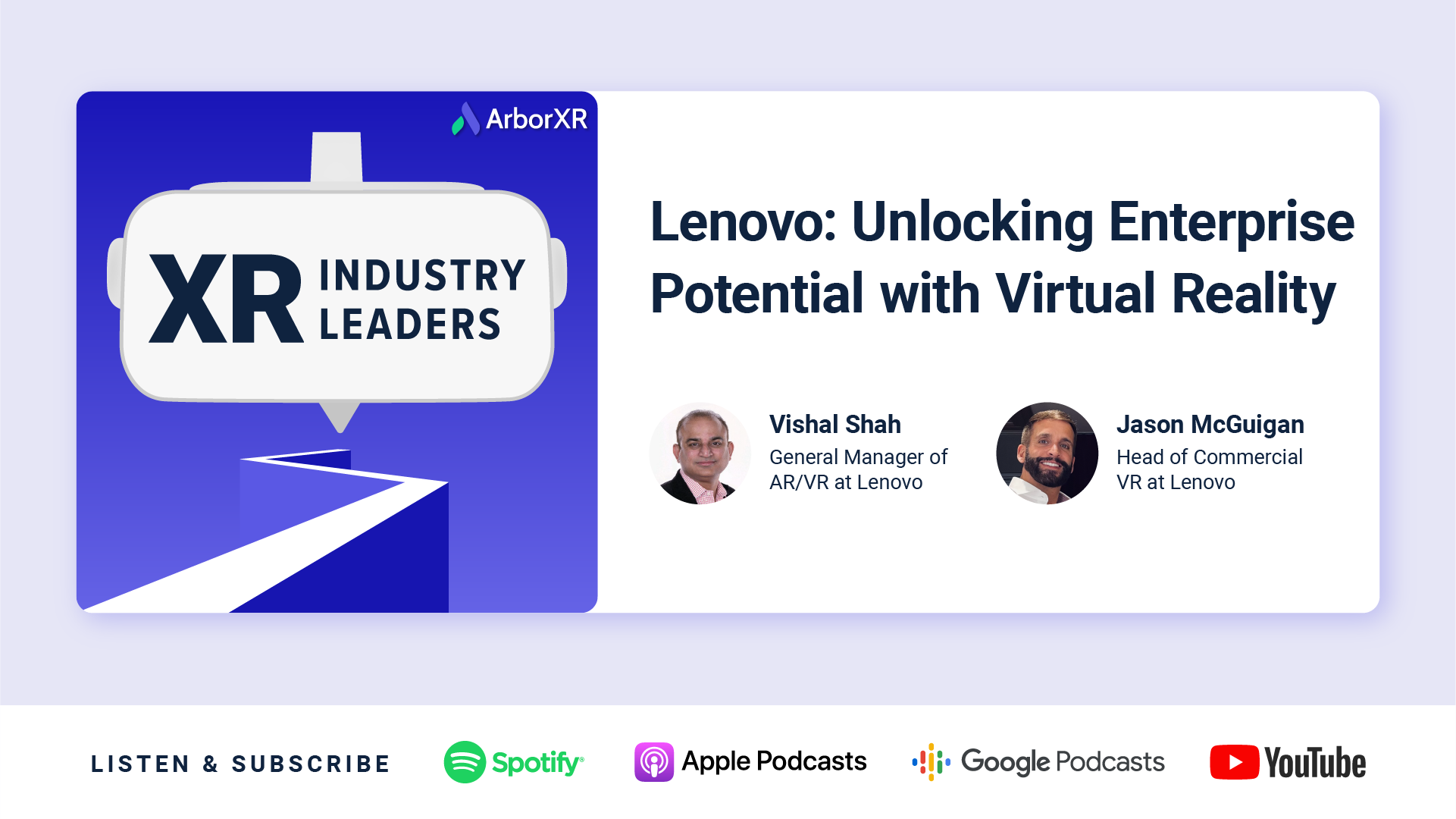
Lenovo: Unlocking Enterprise Potential with VR
Dive into the dynamic world of extended reality (XR) with Lenovo’s Vishal Shah and Jason McGuigan as they unravel Lenovo’s new enterprise XR solution: the Lenovo ThinkReality VRX.

PICO: Practical Enterprise Applications in XR at Scale
Explore XR’s future with PICO’s Amir Khorram in XR Industry Leaders. Insightful discussion on VR enterprise solutions, partnerships, and industry adoption.
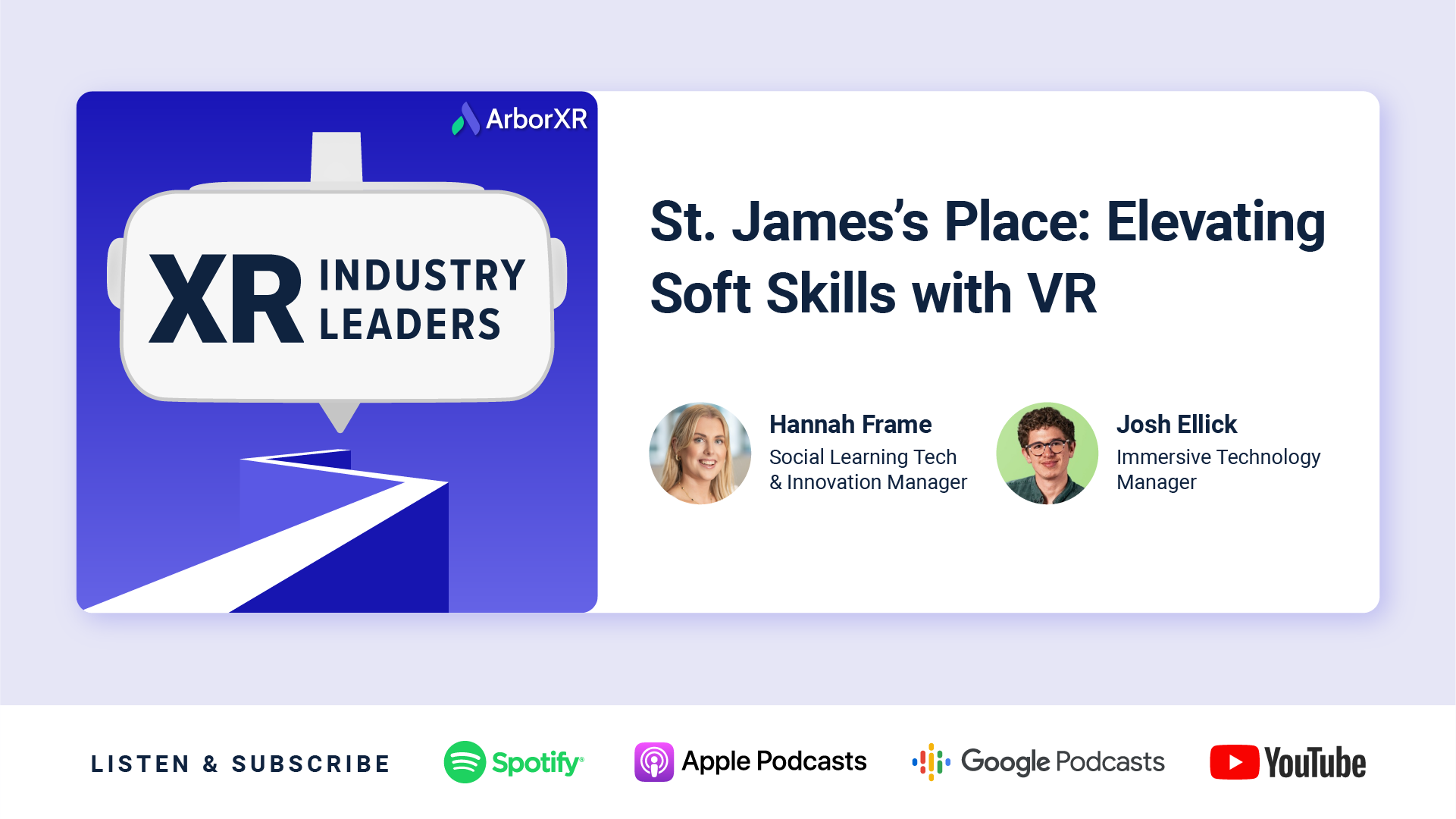
St. James’s Place: Elevating Soft Skills with VR
Hannah & Josh St. James’s Place discuss using VR to train advisor soft skills, challenges of managing headsets at scale, lessons on user adoption, and content development.
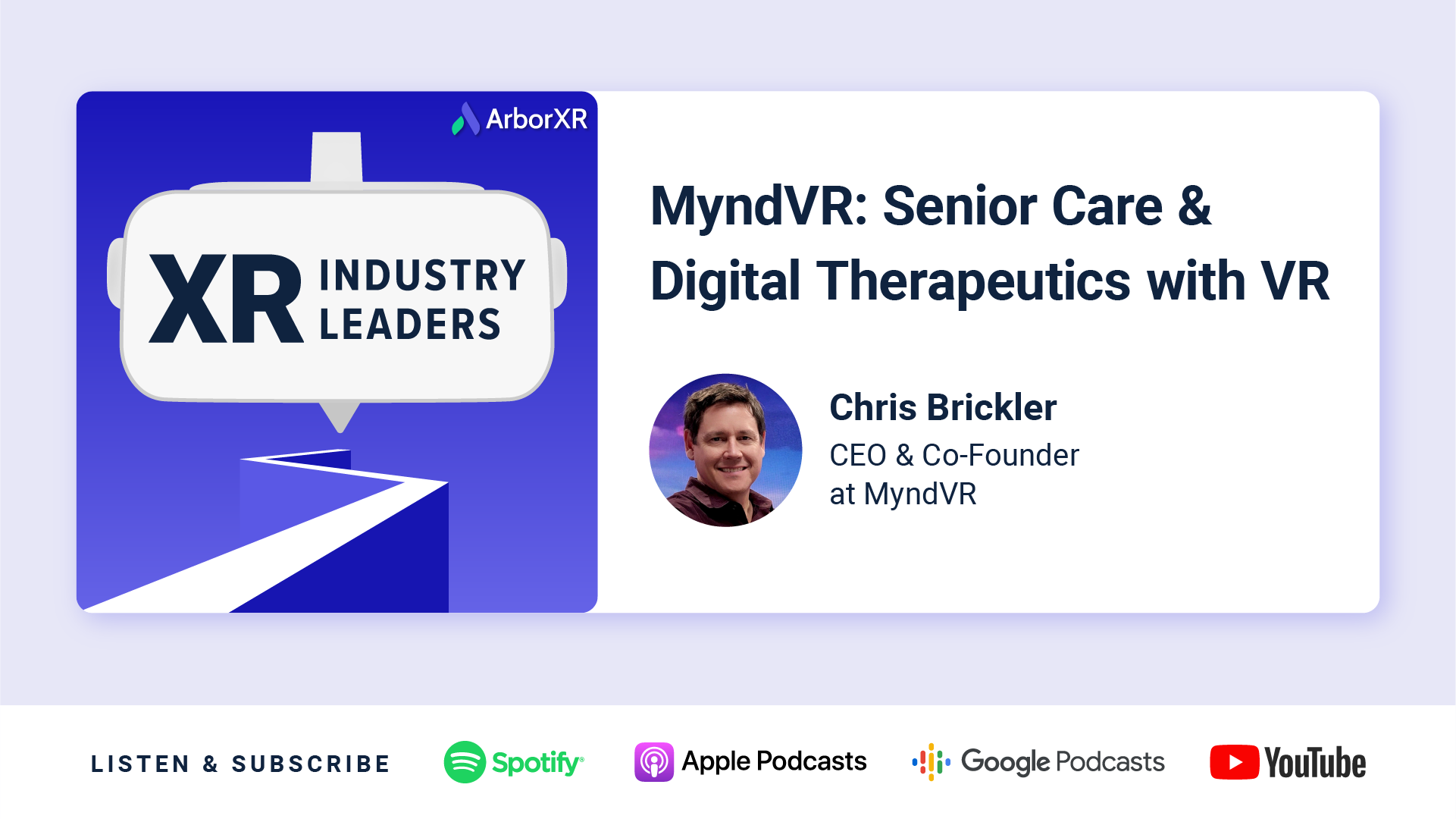
MyndVR: Senior Care and Digital Therapeutics with VR
Chris Brickler shares how VR therapy improves memories and care for elderly patients, and the challenges of scaling VR across health senior care facilities.
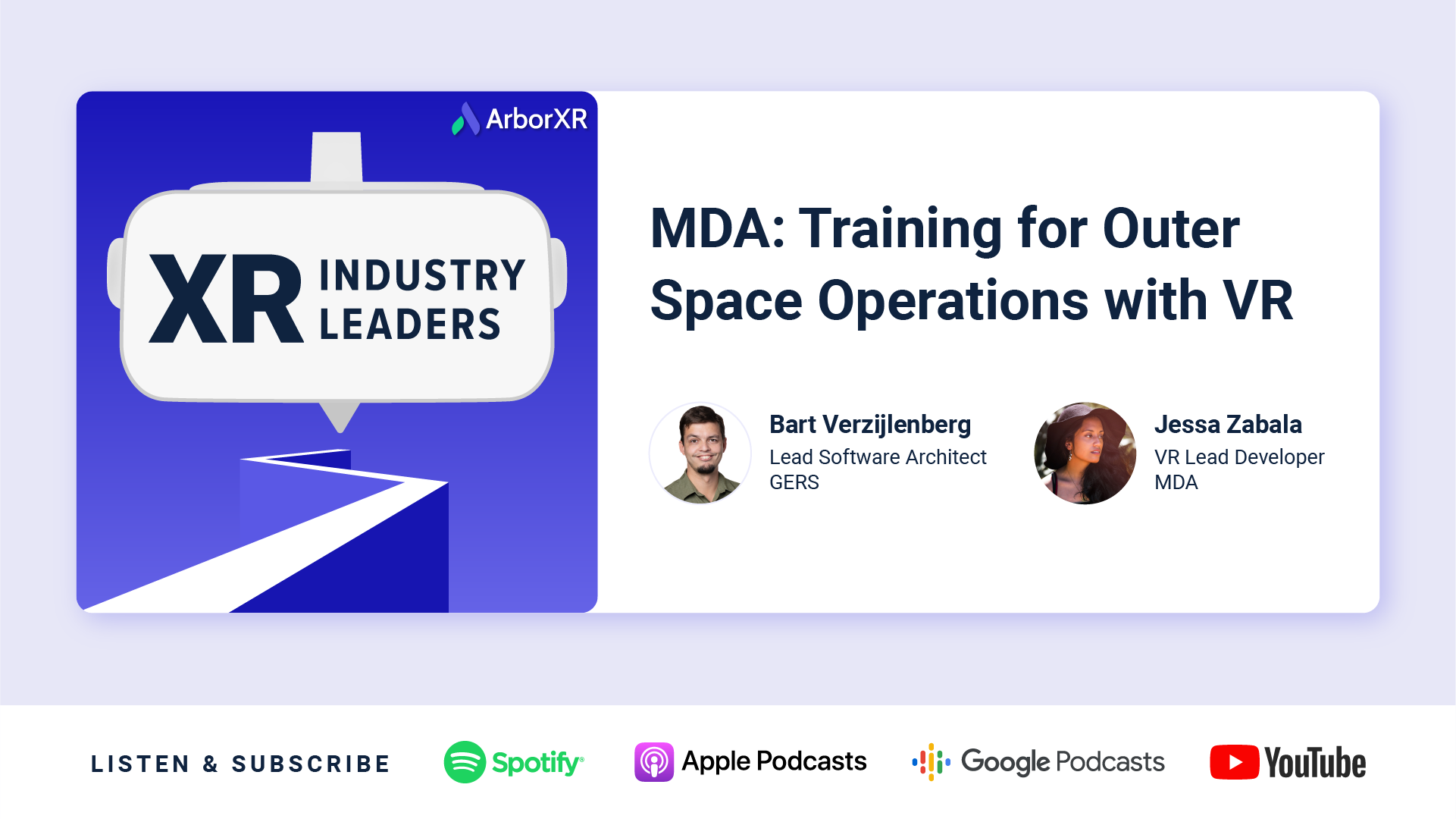
MDA: Training For Outer Space Operations with VR
Discover how MDA leverages VR for astronaut training, mission planning, and onboarding. Gain valuable insights into implementing immersive technologies at scale.

Harvard: Experiential VR Learning in Education
Matt Cook from Harvard joins us to discuss how virtual & augmented reality are redefining higher education through customized immersive experiences.
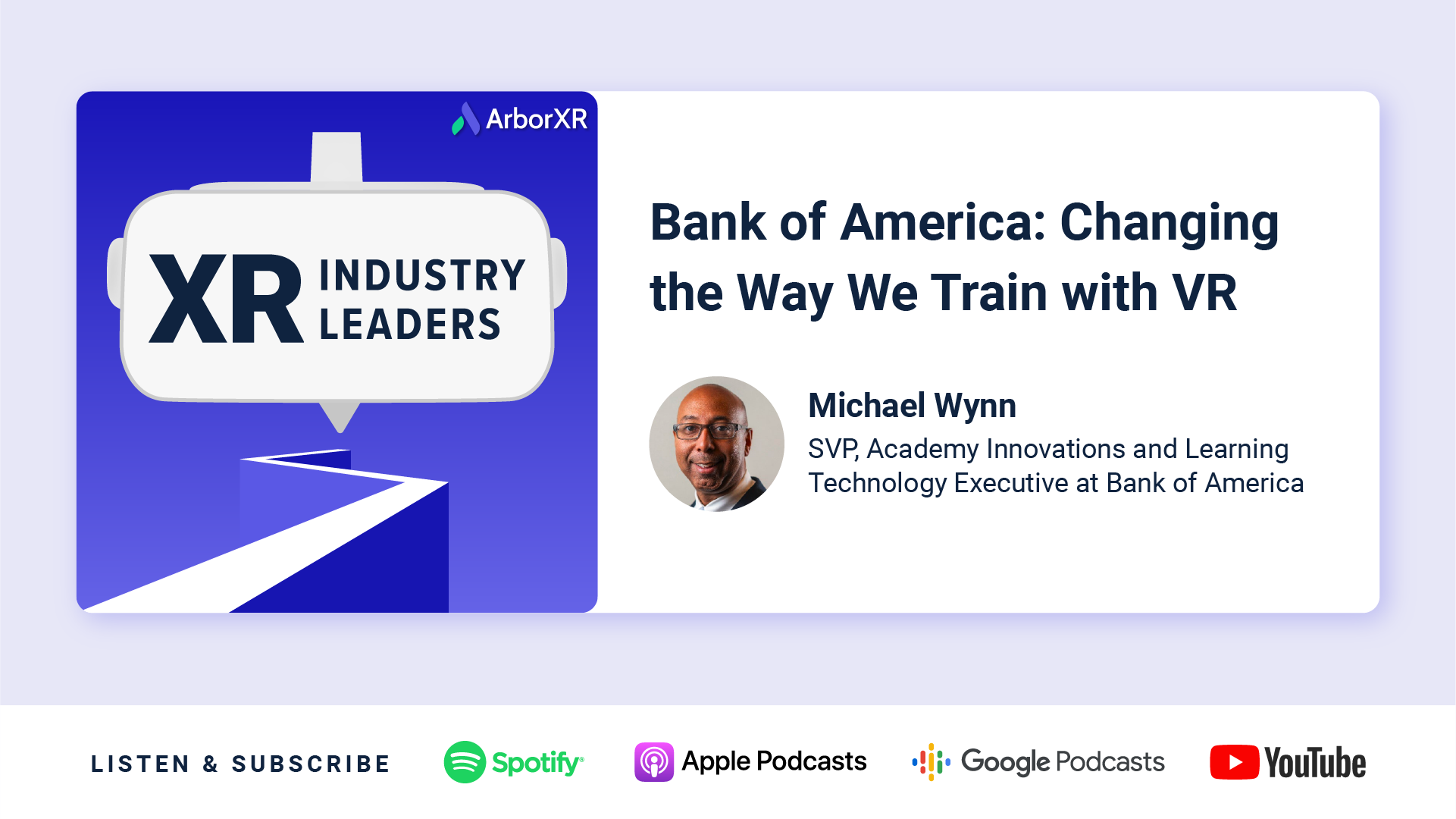
Bank of America: Changing the Way We Train with VR
Explore how Bank of America is revolutionizing training with VR, enhancing employee engagement, overcoming challenges with VR, and redefining corporate education.
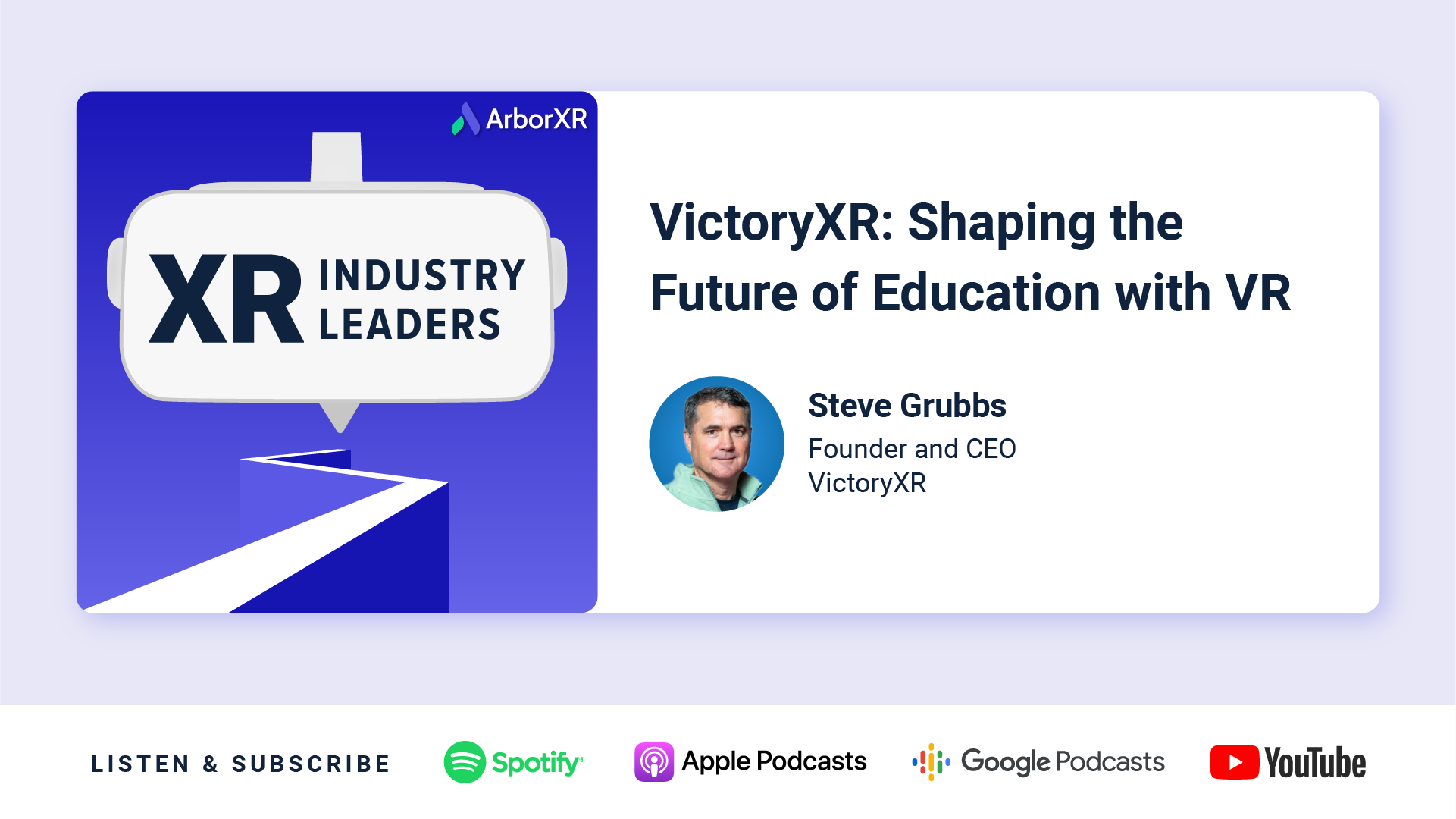
VictoryXR: Shaping the Future of Education with VR
VictoryXR CEO Steve Grubbs discusses creating virtual reality curriculums for education, working closely with Meta, and the future of immersive technology for teachers and students.

VRpatients: Designing Your Own VR Training for Healthcare
Learn how VRpatients creates VR simulations that instructors can customize to give trainees real-life experiences in healthcare.
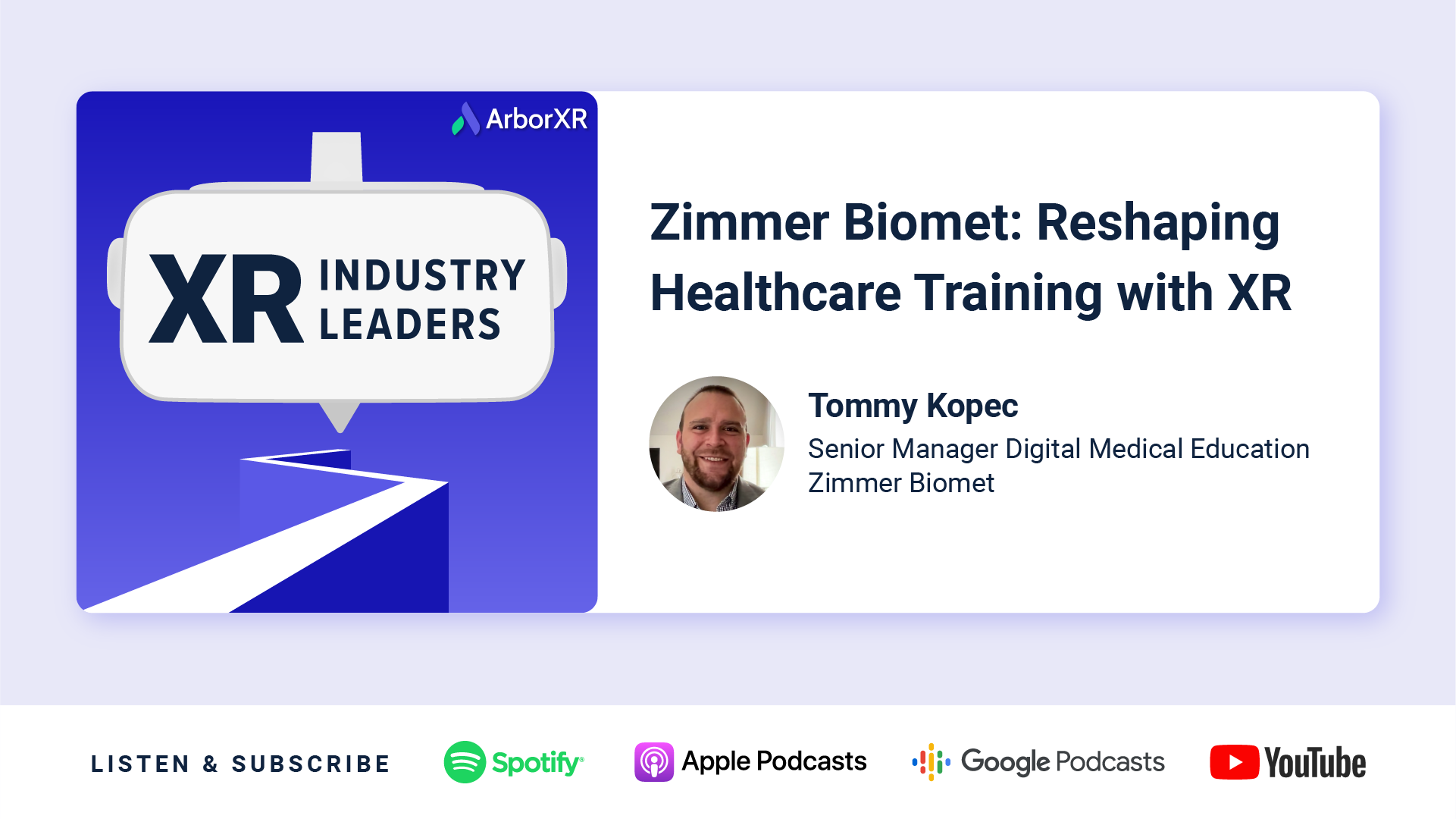
Zimmer Biomet: Reshaping Healthcare Training with AR and VR
If you’re interested in how XR will shape medicine going forward, this is a must-listen episode. Tommy Kopec of Zimmer Biomet provides an insider’s perspective on VR’s transformative potential for surgery, training, and beyond.

Lenovo: Unlocking Enterprise Potential with VR
Dive into the dynamic world of extended reality (XR) with Lenovo’s Vishal Shah and Jason McGuigan as they unravel Lenovo’s new enterprise XR solution: the Lenovo ThinkReality VRX.

PICO: Practical Enterprise Applications in XR at Scale
Explore XR’s future with PICO’s Amir Khorram in XR Industry Leaders. Insightful discussion on VR enterprise solutions, partnerships, and industry adoption.

St. James’s Place: Elevating Soft Skills with VR
Hannah & Josh St. James’s Place discuss using VR to train advisor soft skills, challenges of managing headsets at scale, lessons on user adoption, and content development.

MyndVR: Senior Care and Digital Therapeutics with VR
Chris Brickler shares how VR therapy improves memories and care for elderly patients, and the challenges of scaling VR across health senior care facilities.

MDA: Training For Outer Space Operations with VR
Discover how MDA leverages VR for astronaut training, mission planning, and onboarding. Gain valuable insights into implementing immersive technologies at scale.

Harvard: Experiential VR Learning in Education
Matt Cook from Harvard joins us to discuss how virtual & augmented reality are redefining higher education through customized immersive experiences.
Upcoming
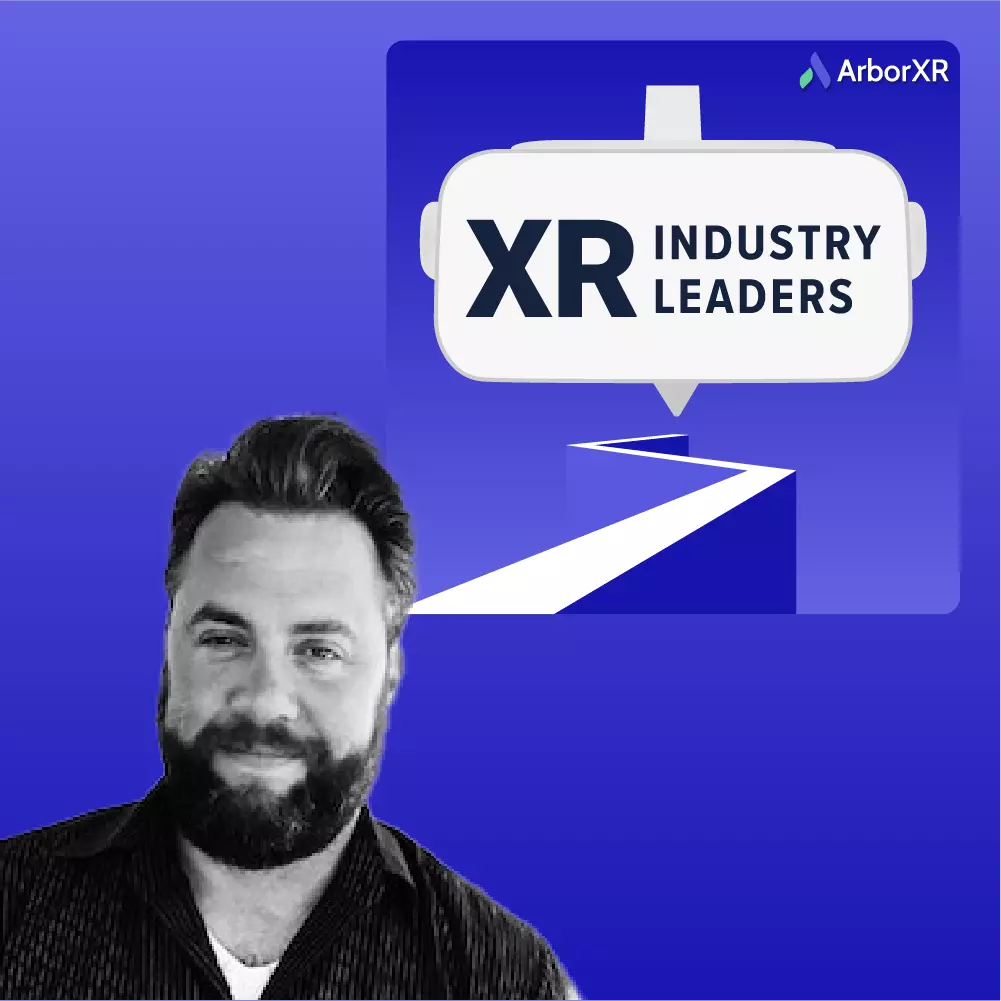
Upcoming Episode
Amazon (AWS)
With Stephen Curtis, Senior Prototyping Architect for Spatial Computing at Amazon Web Services (AWS)
Available: March 2023
